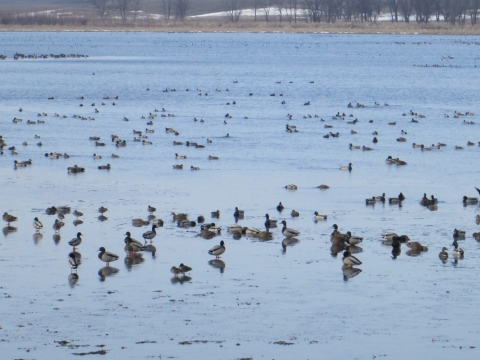Seasons of Wildlife
Spring
March transitions from the silence of winter into a boisterous mix of sights and sounds as the tens of thousands of birds hurry their way north. Canada geese, white-fronted geese and trumpeter swans typically lead the northward flight and are followed shortly thereafter by mallards, northern pintails and a variety of diving ducks. Later arriving waterfowl such as blue-winged teal and gadwall peak in April as a wide array of herons, egrets, ibis, shorebirds, songbirds and raptors such as peregrine falcons join the fray.
Summer
By mid-May, the migration party is largely over and the refuge’s role as a breeding ground becomes paramount. Canada goose broods and some mallard broods are already bustling about as blue-winged teal carry on the customary head bobbing of courtship. Colorful bobolinks take to their singing flights having freshly arrived from their winter vacation in Argentina. All the while, a chorus of frogs dutifully sings throughout the marsh. By August, the refuge falls silent again as courtship has ended and waterfowl carry out a molt that leaves them flightless. Trumpeter swan broods will remain intact into September as the cygnets slowly gain the strength to fly.
Fall
For early migrating shorebirds, fall actually begins in late July and peaks in August. They are delighted by the buffet of food produced during the summer and left on the mudflats and in the sheet water following the heat of the summer. Watch as this same shallow water smorgasbord feeds thousands of larger migrating species ranging from mallards and northern pintails to great blue herons and great egrets. As the fall progresses towards winter, ice forms on the marsh. Thousands of mallards, northern pintails and Canada geese use their collective body heat to maintain pockets of open water in the ice. All the while bald eagles hold watch nearby - hoping for a tasty snack!
Winter
Eventually the snow comes, and the refuge returns to the desolate silence of the northern Iowa winter - broken only by the occasional lonely howls of coyotes in the distance longing for spring’s boisterous return!
Featured Species
Union Slough National Wildlife Refuge is the epicenter of trumpeter swan nesting in Iowa. Up to 15% of the state’s swan nesting occurs on the refuge and surrounding waterfowl production areas. In addition, the refuge can hold more than 200 trumpeters at any one-time during migration.
The refuge supports nine species of breeding ducks, as well as Canada geese. In all, more than 240 species of birds have been seen on the refuge with more than 100 nesting species.
Federally threatened prairie bush-clover and state endangered Blanding’s turtles are found on the refuge. The refuge is home to a variety of resident wildlife including river otters, American badgers, white-tailed deer, wild turkey, ring-necked pheasants and coyotes.


